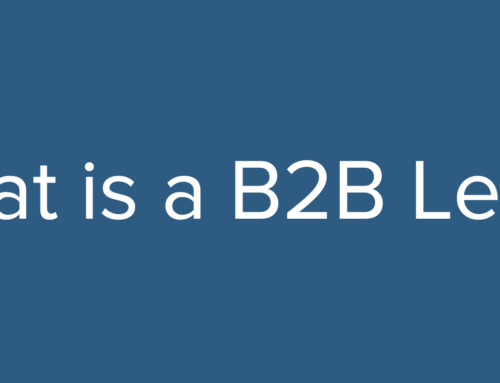Your “marketing” cheese got moved and I am writing to help you find it. To that end, here are the two things your organization must embrace in terms of sales and marketing in this new technology-driven world.
Technology has completely and radically changed the way your potential and existing customers engage with and purchase from your company.
The spoils will go to the suppliers who commit to engaging customers on their terms – the supplier who can leverage marketing to drive that engagement to sales.
Effective selling, shaping what customers want to buy
The most effective B2B sales person seeks to engage with a customer early in the buying process. This is a given. This is the “gold” of sales where a sales person can actually shape the customer’s needs, provide information that leads that customer towards the solution that the sales person represents, and certainly impact any request for proposal by guiding the customer on requirements.
Before technology forever changes our world, marketing and sales worked together to make that happen. Consider the chart below (Chart 1). This picture represents the typical buying cycle of customers. The line that overlays the chart represents the overall ability to influence a customer in the buying process. This chart reflects the desired point of sales contact – early in the cycle when there is more influence, more control over information provided to the customer, more opportunity to educate the prospect, and certainly more impact on shaping the needs and requirements.
Chart 1 – Influence Opportunity Model
In the past, marketing would create demand through various branding activities in media, customers that were just starting to realize the need for a solution would reach out to the company or companies that appeared to be leaders in that segment, and a sales person would engage with them (the red arrow). Customers relied on sales people to educate them, provide critical information, and assist them in learning what solutions might be available and viable. In other worlds, the sales person that shaped the thinking had a huge head start in winning.
Marketing, in that world, worked to create a general awareness and great reputation for the brand, and then primarily served to generate sales collateral that the sales team could use in educating the market and win.
However, that world was shattered by the empowerment found in technology, specifically the ability to find vast amounts of information on the web through search functions – and this forever shifted the role of marketing in terms of content, delivery, and purpose.
Buying Completely and Radically Changed
There are three reasons that the cheese is now in a different place and that represents what I call the new world orders. The remainder of this post will focus on the first new world order.
New World Order #1 – Prospects no longer rely on supplier sales contacts to gain the knowledge they need to make decisions.
A well-documented and widely published, but somewhat controversial research study analysis from the CEB (Corporate Executive Board) along with Google, suggests that today’s B2B customer is roughly “57% through their purchase process BEFORE engaging a sales person from a supplier.” (You can download “The Digital evolution in B2B Marketing Research” report here to read more).
To provide context, the report states:
“To understand the scope of this issue in the B2B context, CEB Marketing Leadership Council surveyed more than 1,500 customer contacts (decision makers and influencers in a recent major business purchase) for 22 large B2B organizations (spanning all major NAICS categories and 10 industries). In a striking finding, the survey revealed that the average customer had completed more than one half of the purchase decision-making process prior to engaging a supplier sales rep directly (Figure 1). At the upper limit, that number ran as high as 70% (Figure 2). The fundamental implication is clear: companies that fail to “show up strong” in this context are underserving potential customers and at risk of losing mindshare and, ultimately, sales opportunities.”
Given the availability for prospects to use the vast resources on the web to perform initial research, including large amount of information directly available from suppliers’ sites, and given that a day where many prospects can easily hide behind caller-id and email, there is no doubt in my mind that this does support my new world order to some degree (see below for a counterpoint).
If we now take our first chart and produce Chart 2 using this new information, you see that if prospects engage with sales about 57% through the buying process, this basically means that for those prospects, sales would be competing at an RFQ stage, more as a “do you have what I say I want, and how much does it cost” stage, and we all agree that your B2B company is not going to experience the sales success you want if you are just responding to RFQs. Sales can have very little influence at this stage in shaping customer requirements wants and you just have to hope they “require” what you are selling.
Chart 2 – Later Sales Engagement in the Influence Opportunity Model
There is a counterpoint to this view. In fact, there are some in the industry that truly took offense to this. You can find one very frank opposition to this in the words of Mike Weinberg, the CEO of The New Sales Coach, and the author of New Sales Simplified: The Essential Handbook for Prospecting and New Business Development. Mr. Weinberg is certainly right in proclaiming that we don’t want underperforming sales people saying things like, “I don’t need to hunt for new business because that doesn’t work, anyway. Let me just spend my time on LinkedIn and Twitter or following up on the wonderful leads our inbound marketing effort is generating.”
If you check out his article, “Debunking the Myth that Buyers are 67% Through the Buying Process Before Engaging Salespeople,” you will also read that,
“The only time buyers get that far down the path without engaging a salesperson is when the seller is sitting on his or her butt waiting for the prospect to raise their hand!
I’m working with several companies in various industries that are experiencing record sales performance. The main driver of that success? Salespeople are strategically targeting and proactively pursuing potential clients before they’re a lead, before they’re shopping. My clients’ salespeople are getting to the opportunity early, often before their reactive competitors would even consider it an “opportunity.”
He also presents that SiriusDecisions, in their 2015 B-to-B Buyer Study, clearly unveiled results that fully debunk this myth. One conclusion of this study published stated that “The new way to think about b-to-b buying is that human interactions still occur and matter, and that the rise of digital marketing doesn’t mean those interactions go away.”
Both are True and Meaningful, and Actionable!
Where does that leave us when we consider both sides. Well, they are both true! Having read and digested these seemingly opposite views, what I realized is that both approaches are trying to get to the same place, but from a different starting point.
The findings in the CEB study point to the fact that as digital search, email, and other technology has the tendency to pull prospects away from early contact with sellers, and digital marketing specifically has a significant presence in their day to day working environment, it is absolutely essential to embrace the new role of marketing in terms of education, content, and other deliverables that can assist sales by creating actionable leads that “want” sales to get involved in their buying process.
This study by no means is trying to say that sales people should just wait on leads. In fact, if anything, it should motivate sales to get involved early. At the same time the study awakened the marketing community to a real shift that, in the absence of those great salespeople doing their jobs all the time, and where a prospect is simply “not” on the radar as a potential customer at all, should light a fire under the marketing community to educate and nurture prospects and then connect them to sales as quickly as possible when they respond as a lead.
As for Mr. Weinberg and the SiriusDecisions study, I say “amen” to all that as well. Yes, let’s all hire great sales people, or train sales people to be great, and ensure that they are present in the prospect relationship enough that they are the “go to” person for education, needs definition, requirements outlining, and then close the deal. That SHOULD happen.
However, that in no way means that sales people don’t want effective digital marketing and effective lead management that can deliver “responses” directly to them. Just recently, and this happens often, I saw a lead that responded to a campaign and when the sales person got the lead, that sales person said, “Oh yes, they are my account. I know them well.” Really? Did you know they were very interested in knowing more about ……?”
There is truth in the first new world order – that prospects no longer rely on supplier sales contacts to gain the information they need to make decisions. However, if they have a good sales rep, they will anyway, because they trust that person and it will save them time and energy.
The rest of the world order
But wait – there is redemption in these same technologies to both enable marketing and sales to push back into the sales cycle and accomplish the goal of reaching people early before they form their own assumptions and requirements. Marketing professionals have been moving, and need to move, with the “cheese” to the place of success enabled by technology. And that will be my focus in the next installment. Watch The Point blog for an update and I’ll also include the follow-up story in our next newsletter.








